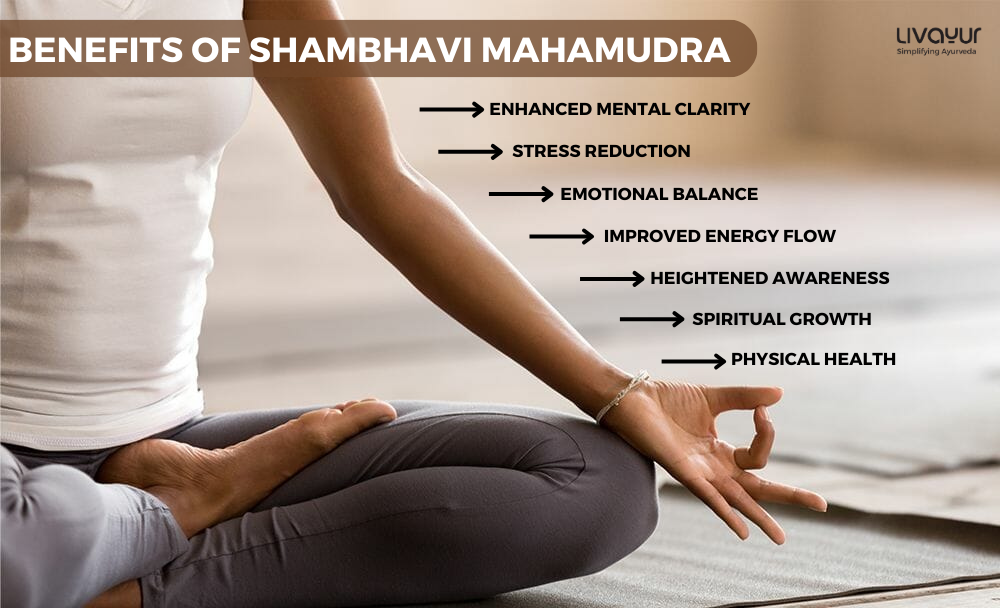
Have you heard of the divine ‘third eye’? The concept of the third eye, or Tritiya Nayan, is deeply rooted in ancient Hindu spiritualism. Not just the Gods and Goddesses, even we have a third eye, and we can open that third eye by practicing certain Yogic Kriyas. Shambhavi Mahamudra is one such Kriya.
It is a profound yogic practice encompassing deep breathing and meditative aspects. This ancient practice is rooted in the yogic traditions of India and is considered a powerful technique for enhancing one’s overall well-being, decreasing stress, and fostering spiritual growth. [1] In this article, we will delve into what is Shambhavi Mahamudra, the practice of Shambhavi Mahamudra, Shambhavi Mudra benefits, and the Shambhavi Kriya steps involved.
Benefits of Shambhavi Mahamudra
Here are some of the notable Maha Mudra benefits:
1. Enhances heart rate
The practice of Shambhavi Mahamudra Kriya has been associated with enhanced heart rate variability and a more balanced sympathovagal state in practitioners.
This increased heart rate indicates a harmonious interplay of vagal inputs during both supine rest and deep breathing among yoga practitioners. It also indicates that practitioners of this yoga develop enhanced adaptive cardiac responses to everyday stressors over the long term.
2. Improves stress management
Shambhavi Mahamudra practitioners show distinctive vagal and sympathetic modulation patterns in response to the various pranayama techniques integrated within the Kriya.
Consequently, the Shambhavi Mahamudra Kriya emerges as a naturally accessible and economically feasible breath-centered practice that holds the potential to mitigate stress and foster overall well-being. [1]
3. Enhances mental clarity
Shambhavi Mahamudra Kriya stands as a promising breath-centered practice that enhances mental clarity and overall well-being. It is different from conventional methods like cognitive behavioral therapy (CBT) that aim at behavior change through awareness of sensations, thoughts, and beliefs linked to emotions. This practice involves a natural, observational focus on arising experiences. This approach fosters personal insight and self-regulation. Certain studies also hint at the beneficial prospects of blending mind-body practices like Yoga with CBT in treating mood disorders, leading to a possible synergistic effect.[2]
Enhanced coherence signifies improved connectivity among brain regions, fostering better information exchange, functional coupling, and coordination. This increased coherence often correlates with higher IQ, creativity, emotional stability, and cognitive flexibility.
4. Improves energy flow
Shambhavi Mahamudra ignites a transformative surge, enhancing energy flow within the body. This practice fine-tunes the energetic pathways by harnessing prana, amplifying vitality and mental vigor. It optimizes the subtle channels, cultivating a harmonious balance that revitalizes the entire system. This heightened flow replenishes energy and fortifies mental clarity and inner equilibrium. The practice empowers individuals to tap into a wellspring of renewed vigor, fostering a profound sense of holistic well-being.
5. Ensures emotional balance
Shambhavi Mahamudra benefits include its impact on the Brain-Derived Neurotrophic Factor (BDNF) that fosters emotional equilibrium, cognitive sharpness, and a positive state of being. Elevated BDNF levels through this practice contribute to emotional balance, mental acuity, and a heightened sense of well-being. This increase in BDNF positively influences emotions, ensuring a harmonious and pleasant experience facilitating emotional stability, mental clarity, and an enhanced quality of life.
6. Heightens awareness
Researchers suggest that meditation and Shambhavi Mudra enhance attentional resource allocation. Another study involving yoga practices observed improvements in attentional tasks, attributing these enhancements to cognitive system changes in meditators compared to non-meditators. Thus, Shambhavi Mahamudra elevates consciousness through focused practice. This ancient technique cultivates heightened awareness by fostering inner clarity and promoting a profound sense of mindfulness. It enables individuals to delve deeper into self-awareness and embrace heightened consciousness.
7. Promotes spiritual growth
Shambhavi Mahamudra serves as a catalyst for profound spiritual expansion. It also acts as a gateway to profound inner peace. By harmonizing the flow of prana and guiding focused attention, this practice cultivates a serene internal landscape. It helps individuals transcend turmoil, nurturing a deep sense of tranquility and harmony within, fostering a sustained state of inner peace amidst life’s challenges, and unlocking deeper dimensions of self-discovery, leading to a profound evolution of consciousness and spiritual growth.
8. Improves sleep quality
According to studies that analyzed sleep patterns in meditators practicing Shambhavi Mahamudra and other Isha Yoga methods, compared with age and education-matched non-meditators, the meditators aged 25 to 55 displayed notably higher REM sleep, sleep efficiency, and total sleeping time. They also experienced improved sleep quality with fewer awakenings after sleep onset, suggesting a positive influence of Shambhavi meditation on sleep quality.
9. Reduces menstrual issues
Studies reveal that a high percentage of women experience impactful menstrual issues affecting their physical, psychological, social, and economic aspects. Traditional treatments, often unsatisfactory even with surgeries as a last resort, prompt exploration of alternative therapies like yoga. It has been seen that Shambhavi Mahamudra practitioners aged 14-55 across different countries have had results after six months, and these revealed substantial improvements in various menstrual disorders, suggesting Kriya is a promising adjunct therapy.
10. Aids in depression management
It has been observed that elevated alpha band power in Shambhavi practitioners is indicative of lower stress levels. Delta and theta band activity notably increased, while beta band power decreased. Reduced beta band activity suggests decreased susceptibility to mental tension, excitement, and anxiety. Higher theta and delta activity are associated with accessing deeper meditative states, reflecting an intuitive, empathetic sense.
Shambhavi Mahamudra Steps
Shambhavi Mahamudra involves a combination of breath control, meditation, and focus. Here are the steps on how to do Shambhavi Mahamudra:
Step 1:
The initiation of the Shambhavi Mahamudra Kriya involves a minute of contemplation on the fundamental principles presented during the program.
Step 2:
Following this introspective moment, 3 gentle and preparatory yoga postures are performed, lasting for 5 minutes.
Step 3:
The core of the practice, the 21-minute Kriya (inner action), is conducted while in the Siddhasana (accomplished pose), a cross-legged posture where the left heel presses the perineum.
Step 4:
The Shambhavi Mahamudra steps start with Sukha Kriya or Nadi Shodhana, a controlled yogic breathing technique focusing on alternate-nostril breathing, practiced for 6 to 7 minutes. This pranayama aims to establish mental equilibrium.
Step 5:
Following the pranayama, 21 elongated repetitions of the bija mantra “Om” are vocalized aloud, while the thumb and forefinger touch in jnana (wisdom) mudra (gesture).
Step 6:
The practice continues with Viparita Swasa or Bhastrika pranayama, a fast-paced breathing exercise executed for 3 to 4 minutes.
Step 7:
The Shambhavi Mahamudra Kriya steps conclude with breath retention (kumbhaka) during both inhalation and exhalation. This is augmented by the activation of the bandhas (muscular and energetic contractions) in the pelvic floor (moola bandha), lower abdomen (uddiyana bandha), and throat (jalandhara bandha).
Step 8:
The final phase entails 5 minutes of Vipassana or open-monitoring meditation (dhyana).
Step 9:
Notably, the comprehensive Shambhavi Mahamudra Kriya takes approximately 21 minutes to complete. [1]
Precautions to follow while practicing Shambhavi Mahamudra
- Release the Mudra if you experience heightened strain between the eyes.
- Beginners should avoid prolonged poses if they feel retinal pain or intense forehead discomfort.
- Avoid overexertion to prevent dizziness or mild headaches.
- Remove contact lenses or glasses before practicing the Shambhavi Kriya steps to avoid hindrances.
- If you had a recent eye or brain surgery, you should seek expert advice before attempting the pose to prevent potential complications.
Who should practice Shambhavi Mahamudra, and who should avoid it?
| Who can practice | Who should avoid |
| All people, irrespective of their background or experience | Those who underwent eye or brain surgery recently |
| – | Those with an eye lens implant |
| – | Those who are suffering from Diabetic retinopathy or glaucoma |
FAQs
1. What are some useful tips for practicing Shambhavi Mahamudra?
Consistency: Regular practice is key to experiencing the full benefits of Shambhavi Mahamudra. Dedicate a specific time each day for your practice.
Posture: Sit comfortably with your spine erect. A straight spine supports the smooth flow of energy during practice.
Breathing: Maintain a gentle and rhythmic breath. Avoid forcing or straining the breath; let it flow naturally.
Focus: Keep your gaze soft and relaxed while directing it towards the point between your eyebrows. Avoid any tension in the eyes.
Mantra: If using a mantra, choose one that resonates with you. Feel the vibration of the mantra as you repeat it mentally.
Distractions: It is normal for the mind to wander during practice. Whenever you notice your mind drifting, gently bring your focus back to the point between your eyebrows.
Gradual Progress: If you are new to meditation or yogic practices, start with shorter durations and gradually increase the time as you become more comfortable.
2. How does Shambhavi Mahamudra bring about mental clarity?
Shambhavi Mahamudra involves focusing the gaze at a point between the eyebrows, which is believed to activate the Ajna Chakra, the center of intuition. This can lead to improved mental clarity, concentration, and focus.
3. Is Shambhavi Mahamudra good for physical health as well?
Shambhavi Mahamudra’s practice can positively affect the nervous system, cardiovascular health, and respiratory system. It is also said to improve digestion and metabolism.
4. Is Shambhavi Mahamudra good for weight loss?
Shambhavi Mahamudra meditation is not directly linked to weight loss, yet its focus-enhancing and clarity-improving effects might indirectly assist. Better focus and mental clarity could encourage healthier lifestyle choices regarding diet and exercise, contributing to weight management, albeit not as a direct weight loss method.
5. How can I restart Shambhavi Mahamudra practice?
To resume Shambhavi practice, after an interruption, it is advised to complete a mandala involving 40 consecutive days of Kriya twice daily, without any gaps. If you have paused the practice and intend to restart, following this mandala routine is highly recommended to reestablish the practice effectively.
Conclusion:
Shambhavi Mahamudra is a transformative practice that offers holistic bodily, mind, and spirit benefits. With its emphasis on focused awareness, breath control, and inner stillness, this practice provides a pathway to self-discovery, mental clarity, and spiritual growth. As with any yogic practice, patience and consistency are key, and practitioners can experience the profound effects of the ‘eyebrow center gazing’ or Shambhavi Mahamudra in Hindi over time.
Disclaimer:
This article is written from a health and wellness perspective and is not medical advice. Kindly seek the help of a certified medical practitioner before initiating any treatment.


















Utterly composed articles, regards for selective information.
I take pleasure in, cause I found just what I used to be taking a look for. You’ve ended my 4 day lengthy hunt! God Bless you man. Have a nice day. Bye
Enjoyed looking through this, very good stuff, appreciate it. “Talk sense to a fool and he calls you foolish.” by Euripides.
e39qqh
What’s Happening i am new to this, I stumbled upon this I’ve found It absolutely helpful and it has aided me out loads. I’m hoping to contribute & aid other customers like its helped me. Great job.
Hello, you used to write fantastic, but the last several posts have been kinda boring?K I miss your super writings. Past several posts are just a little bit out of track! come on!
With every thing which appears to be developing within this specific subject material, your perspectives are generally relatively radical. Nevertheless, I am sorry, because I do not subscribe to your entire suggestion, all be it exhilarating none the less. It looks to everybody that your remarks are generally not entirely rationalized and in reality you are generally yourself not even totally confident of the point. In any event I did enjoy reading it.
I do enjoy the manner in which you have framed this matter plus it really does offer me some fodder for consideration. On the other hand, from just what I have experienced, I only trust when other responses stack on that people remain on point and don’t get started upon a soap box regarding the news of the day. Still, thank you for this excellent piece and although I can not agree with this in totality, I regard the point of view.
Hi there! I just wanted to ask if you ever have any problems with hackers? My last blog (wordpress) was hacked and I ended up losing a few months of hard work due to no back up. Do you have any methods to stop hackers?
Your place is valueble for me. Thanks!…
Thank you for sharing superb informations. Your website is so cool. I’m impressed by the details that you have on this website. It reveals how nicely you understand this subject. Bookmarked this web page, will come back for more articles. You, my friend, ROCK! I found just the info I already searched all over the place and simply couldn’t come across. What a perfect site.
hello!,I like your writing so much! share we communicate more about your post on AOL? I need a specialist on this area to solve my problem. Maybe that’s you! Looking forward to see you.